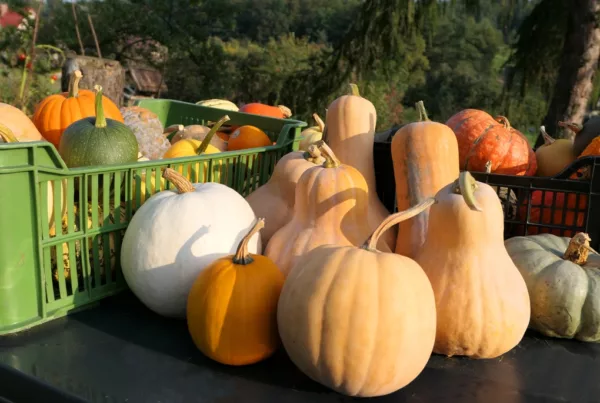Written by Kristina Hicks-Hamblin
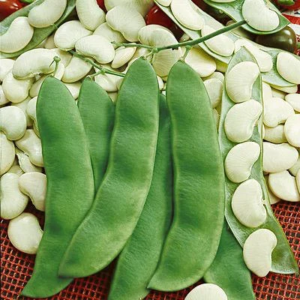
‘Henderson Bush’ lima beans. Photo via Eden Brothers.
With summers getting longer and hotter, and winter weather becoming more unpredictable, climate change is here, and gardeners must learn to adapt. The 2023 USDA Hardiness Zone Map offers proof of what many of us have already observed: warmer growing zones are inching their way north, making gardening more of a challenge in many places. In order to keep growing food in this changing world, we’ll need to adopt climate resilient gardening techniques in our Square Foot Gardens!
Here are some tips to help you ensure a bountiful harvest of all the homegrown crops you love within a changing climate:
Varieties for Climate Resilient Gardening
One of the most exciting ways practitioners of Square Foot Gardening can create resilience in their backyards is by choosing seed varieties that hold up well to drought, cold, or heat.
You’ll find many varieties that are bolt resistant, or cold, drought, or heat tolerant by scouring seed catalogs. Here are some examples you might consider growing in your raised beds:
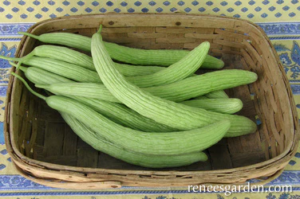
Armenian cucumber. Photo via Renee’s Garden.
Armenian cucumbers: Armenian cucumbers are more heat and drought tolerant than other cukes. They’re actually long, green melons, but since they aren’t sweet, they make a great cucumber substitute. Fruits can measure up to three feet long so grow them on a trellis, and expect 60 days until harvest. You can purchase packs of Armenian cucumber seeds at Renee’s Garden.
Green Striped Cushaw: ‘Green Striped Cushaw’ is a variety of winter squash that is both heat tolerant and drought resistant. Fruits weigh in at seven to 25 pounds and take up to 120 days to mature. You’ll find packs of ‘Green Striped Cushaw’ seeds for purchase at Eden Brothers.
Henderson Bush Lima Beans: ‘Henderson Bush’ lima beans are drought tolerant and early maturing, ready to harvest in just 60 days. Pods are three to four inches long and contain three to four beans each. Find packs of ‘Henderson Bush’ lima bean seeds at Eden Brothers.
Moneymaker: ‘Moneymaker’ is an heirloom tomato variety that is heat tolerant and high yielding, producing tomatoes that weigh four to six ounces each. Count on 80 days until harvest. You can purchase packs of ‘Moneymaker’ tomato seeds at Eden Brothers.
Slogun Lettuce: ‘Slogun’ is a type of green and red crisphead lettuce that is extremely slow to bolt, making it last well into summer. Count 60 to 90 days until harvest.
SFG Accessories for Climate Resilient Gardening
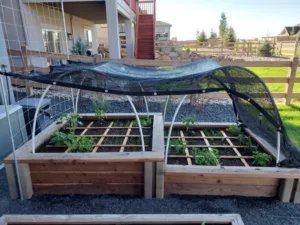
Shade cloth helps keep crops from overheating during heat waves.
Once you have chosen resilient cultivars to grow, the next step is to look to accessories for the Square Foot Garden that will help you extend your growing season – both during hot weather, as well as during unusually cold springs or early falls.
Shade cloth can be used to buffer the heat of the sun during heatwaves. If you already have a crop cage to keep out critters, you can drape shade cloth over it. Or you may want to build a dedicated shade cloth cage to place over your raised bed.
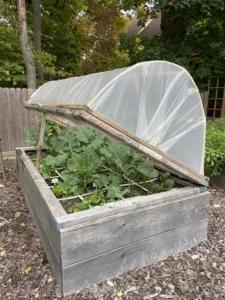
Cold frames and hoop houses protect crops from cold weather and pests.
Learn more about using shade cloth in the SFG – read our article!
Cold frames and hoop houses can help extend the growing season in spring or autumn – or for some gardeners, provide a way of cultivating cold season crops all winter long.
Hoop houses can also be used to protect crops from pests that may be more abundant with changing weather patterns.
Get instructions for building a DIY hoop house right here!
Additional Strategies for Adapting to Climate Change
There are other strategies you will want to adopt as well, and some of these are part and parcel of the SFG Method:
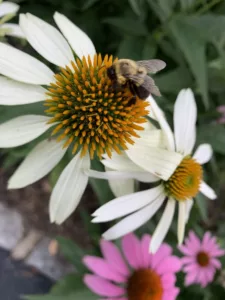
Bumble bees are great allies in the SFG.
Polyculture: Growing a polyculture entails planting an assortment of different types of plants in each raised bed, and was part of Mel Bartholomew’s original vision for SFG. This strategy creates more resilient gardens because if one crop fails, all is not lost.
Wildlife Gardening: Loss of habitat means insects are ever more dependent on human help for food and shelter. So when you plan your layout for your SFG, be sure to include some pollinator friendly flowers, herbs, or perennials. Some crops require pollination for fruiting, and most if not all crops produce better yields when pollinators help out. Keeping beneficial insects as part of your food growing strategy helps nurture the delicate balance of your local eco-system and keep pest outbreaks in check.
Save Seeds: Save seeds from crops that are successful in your garden. By growing and saving seeds from varieties that are well-adapted to your location, you’ll be joining a long held tradition to ensure there’s food in the future. Share these seeds with your nearby friends, family, and neighbors to help create resilience on a community-scale as well.
And of course, when it comes down to it, there’s nothing more resilient than growing your own locally produced food.



